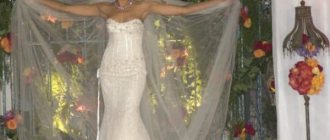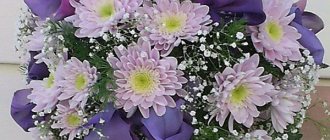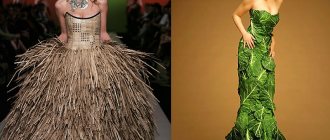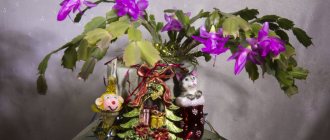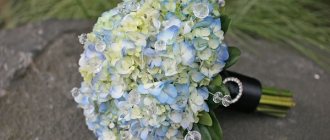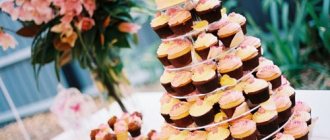Freesia is an incredibly delicate beauty with a subtle, unforgettable aroma, which is winning positions in the wedding setting from the venerable queens of roses, orchids and lilies. It can be seen more and more often in bridal bouquets, either only from freesias, or in tandems with the usual favorites. This is explained primarily by the breadth of the palette; there are white, cream, red, yellow, orange, pink, lilac, violet and blue. In bicolors, the inner arch of the pharynx is often contrastingly colored compared to the petals.
Freesia was brought from the Cape region of South Africa, for which it received the following names: Cape lily of the valley or African iris. The Netherlands is recognized as the leading country that now specializes in the cultivation and selection of this plant.
Tips for caring for cut freesias
In order for the freesia stem to last as long as possible, its cutting is carried out when the top bud has fully opened, and the second and third are in the stage of coloring. When delivering the bouquet to the place where the bouquet is assembled, the flowers must be in water. Even trimming the stems should be done in water. The plant reacts very sharply to lack of moisture and dry air.
When caring for a bouquet, be sure to promptly remove wilted buds and trim the stem daily. The water in the vase should be changed every day, plus add food for cut flowers.
Proximity to vegetables and fruits that emit ethylene is detrimental to freesia. It is especially intensively produced by apples, pears, bananas, peppers, tomatoes and potatoes. Therefore, a vase of flowers should be placed away from the fruit bowl or where vegetables are stored.
If you purchase freesias during the cold season, then pay attention to the number of colored buds; there should be a maximum number of them. At home, without special floral nutrition or substances that promote ripening, the plants will not color and will wither faster. During the warm season the opposite is true. There should be no more than two or three colored buds. The rest will “ripen” at home in a vase, so you can take plants with a large number of green, unbroken buds.
Bride style
The color range of buds is varied. They come in red, lilac, pale blue, cream, and yellow.
Make bouquets based on orange and traditional white flowers, purple, violet in various combinations.
A solo bouquet will highlight any style and style of a festive dress.
A suitable partner for a traditional wedding ceremony is white freesia. It looks great in spring.
You can mix different tones to achieve a certain effect. For example, orange, white and bright red flowers look great with a white wedding dress, giving it a touch of elegance. Pay attention to the photo - how gorgeous the wedding bouquet of red roses and white freesia looks!
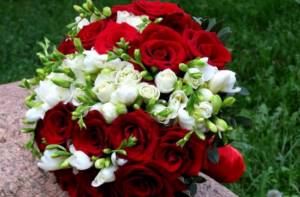
To make a bright accent appropriate, use a handbag, belt, and shoes in matching shades.
Freesias are good in combination with luxurious fabrics of a wedding dress and more everyday ones. Versatility is one of the most important advantages of a flower in terms of creating compositions.
Yellow freesias will be a suitable addition to the “autumn” wedding theme. Catchy purple flowers, attractive tiger buds with their contrast, as well as orange flowers emphasize the unusual theme of the celebration. You should choose similar shades for the groom’s boutonniere - this way the couple will look harmonious.
Combine dark red, burgundy, and white buds - you will get a bright and unusual bridal bouquet of freesias, which will create a contrast against the background of a white outfit or, on the contrary, will become an additional accent to an unusual dress.
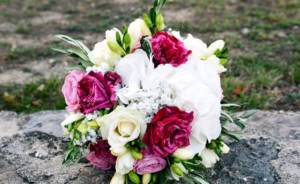
Blue and white combinations and cream and pink freesia arrangements are suitable accessories for romantic parties.
Freesia in wedding style
Freesia is in demand in wedding decorations because its graceful shape can be played out several times. In the bride's bouquet, in the hairstyle, in the design on the veil and dress, in the groom's boutonniere and interior decor. And the recognizable aroma, like that of an expensive perfume, will remain in the memory of the young spouses forever, evoking the most pleasant associations and emotions. A wide range of plant shades provides freedom in choosing accents. When composing a composition in lilac tones, the groom may prefer a suit in the same shade range. Or you can use bright purple ribbons in the decor of the banquet hall.
When choosing a leading color in a wedding setting, pay attention to its semantic meaning:
- white - symbolizes purity, innocence and gentle grace;
- red – passion, ardor of feelings and bright emotions;
- pink - sublimity, romance, naivety and childishness of perception of the world;
- orange - a bright, dynamic, ardent nature with a bit of coquetry and irrepressible cheerfulness;
- yellow – emphasizes the desire for financial well-being, determination and hidden strength;
- blue - expresses the depth of feelings, endless trust in your partner, loyalty to the choice once made;
- purple-burgundy – wisdom, fidelity of feelings and consistency in actions;
- purple – confidence, reliability, seriousness and prudence.
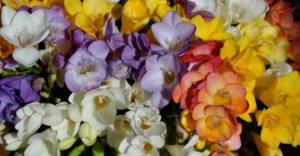
Buy a bridal bouquet of freesias
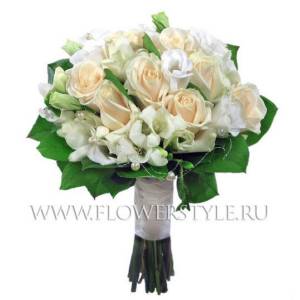
Freesia is a flower from South Africa, more precisely the Cape region. It came to Europe thanks to aesthete sailors who appreciated the delicate aroma and spring-like fresh appearance of the plant. Freesia plants brought to Europe fell into the hands of breeders of royal houses. The rapid development of science has led to the appearance of original buds with petals:
- Blue and lilac shade;
- In pink and orange tones;
- Rich fuchsia or lemon color.
Freesia wedding floristry will highlight the beauty of the future wife, create a special holiday atmosphere, and add notes of spring freshness to the ceremony. Since the 19th century, imported plants have been associated with trust. By presenting such a flower to the bride on her wedding day, the groom declares the seriousness of his intentions and the desire to unite his destiny with the person who is dear to him. There is some symbolism in the color of the selected freesias, although the variety of types allows you to select bouquets in multi-colored designs that look really chic.
Wedding traditions associated with flowers
Girls started getting married with a bouquet of flowers in their hands not so long ago. Before this, there were many beliefs, customs and traditions among different peoples.
- In Ancient Greece, Rome and the Celtic tradition, wreaths woven from aromatic herbs were placed around the young wife’s neck before the marriage ceremony, but not for beauty, but for protection from spirits.
- In medieval Europe, the bride held in her hands not a bouquet of flowers, but bunches of onions, garlic or dill to ward off evil spells that could destroy a young family.
- The tradition of the wedding bouquet dates back to the wedding ceremony of Prince Albert and Queen Victoria of England in 1840, in which she held marigold flowers and sprigs of dill. Young people ate greens after the celebration to inflame passion.
- At the dawn of Slavic identity, girls held fir branches and thistle flowers in their hands, designed to pacify the girl’s will
- In later Slavic culture, the newlywed was often decorated with flowers on her head and pinned to the bodice of her dress.
- In German symbolism, the wedding bouquet consisted only of white flowers, and the head was decorated with a wreath of myrtle; only in this case could one receive the blessing of heaven.
- The tradition of throwing a bouquet to girlfriends originated in America, and the first duplicate bouquet appeared there, created for the same purpose, but designed to preserve the original.
- It is considered correct for the bride to hold the bouquet in her right hand until the marriage certificate is signed, and in her left hand after painting.
- In European countries, there is a tradition: on the seventh wedding anniversary, the husband presents his wife with a bouquet of freesias. This serves as a reminder of the consistency, ardor and freshness of his first feelings for his beloved.

Features of freesias
Freesia is one of the most beautiful flowers. Their main distinguishing feature is delicate flowers in various shades of white, yellow, red, blue and purple.
They have a pleasant, delicate aroma that relieves stress and depression. No wonder they are used in many perfumes.
You can admire the first buds in the last days of July - early August. And they begin to bloom in mid-August. The flowers delight their owners for one and a half to two months, until mid-October.
Freesia bouquets are very durable and can withstand even seemingly unbearable heat. Therefore, they are ideal for weddings and other celebrations.
They have affordable prices. So anyone can afford to buy such beauty.
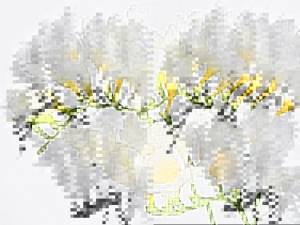
White freesia flowers
History and selection of varieties
Until 1930, one variety of freesia was known, by 1940 - 25 varieties. Only after the end of World War II did breeders take up the plant in earnest. The leading positions were then occupied by Holland, Great Britain, the USA, Denmark, France, and Germany. The flower was brought to Russia in 1963 from Holland. And by 1980, its cultivation on an industrial scale had already begun. In the 90s of the 20th century, the pace of research in Russia continued to increase in the development of varieties resistant to pests, diseases, temperature changes and adaptation to a different climate zone. Since 1997, 20 varieties of double and non-double types have been bred in Sochi. Domestic freesia hybrids are highly resistant and compete well with foreign ones.
Varieties of domestic freesia for cutting:
| Variety name | Description of the variety; flowering time | Bud, cm | Aroma | Color and terry |
| Anyuta | Medium height 60-62 cm, 3-4 peduncles of 8-10 pieces. in inflorescence; mid-early | 5,2*4,6 | Spicy | Yellow non-double |
| Valentina | Tall 90 cm; average term | 7*7 | Strong | Blue-violet non-double |
| Valeria | Tall 87.5 cm; mid-early | 6,5*7,5 | Medium durability | White non-double |
| Cinderella | Tall 91.5 cm; late flowering | 6,5*6,2 | Spicy | Light yellow semi-double |
| Irina | Medium height 62.5 cm, with 2-3 peduncles of 10 pieces. in inflorescence; mid-early | 5,6*4,7 | Nice | Purple-pink non-double |
| Lada | Tall 84.5 cm, in inflorescence 10 pieces; mid-late | 7*6 | Thin | Purple classy non-double |
| Dream | Tall 85 cm, in inflorescence 9-10 pieces, lifespan at bud opening 3 weeks; mid-early | 6*6,2 | Delicate thin | White with a lilac tint, non-double |
| Mars | Tall 79.2 cm, 3 tight peduncles, 8-9 pieces in inflorescence; average term | 7*6,2 | Persistent | Bright scarlet non-double |
| Festive | Medium-sized 73 cm, 2 peduncles, 6-7 pieces in inflorescence; mid-early | 5*6,8 | Strong resistant | Bright yellow terry |
| Gull | Tall 78.1 cm; very early | 7,2*6 | Nice weak | White with a bright blue stripe along the edge, non-double |
| Usurvati | Medium-sized 62.8 cm, 3-4 peduncles, 8-9 pieces in an inflorescence, often grown in pots; early | 5,8*5,3 | Delicate sweet | The middle of the pharynx is crystal white, the outer color is light lilac, non-double |
| Anniversary | Tall 83.5 cm, 2-3 elastic peduncles, 8-10 pieces in inflorescence; average flowering time | 6,9*6 | Lightweight soft | Hot pink non-double |
| Juno | Tall 76 cm; late | 6,5*7 | Light sweet | Pure white. Used in wedding mono bouquets without additions of other flowers. Terry variety |
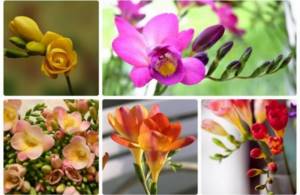
Main types and varieties
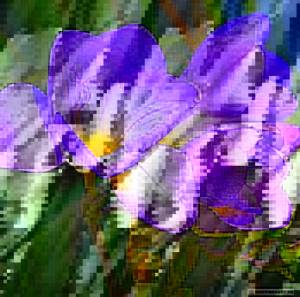
There are about 200 varieties of this flower in total, but the main ones are three types and their most colorful varieties. Their color range is so wide that everyone can find a variety that suits their preferences.
You can grow the plant not only in the garden, but also in the house. Therefore, indoor freesia is a very popular flower, but it is not a separate species or variety. Any of the following options is suitable for growing in a pot, and the main advantage in such cases will be the colorful flowering of the Cape lily of the valley in winter.
Freesia Armstrong
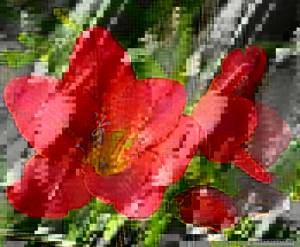
It was this flower that became one of the species for breeders to obtain the most popular hybrid variety. The height of the bush with sword-shaped leaves reaches 65–70 cm. The inflorescences in the form of panicles are decorated with up to five bell-shaped flowers, which have a fragrant aroma and are colored in scarlet and pink (less often red) shades. Colorful blooms delight the eye in May-June. The most beautiful representatives of this species are the flowers of the Cardinal variety. On one inflorescence they bloom up to 10-11 small red flowers.
Hybrid
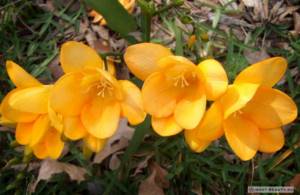
The species freesia hybrida was obtained by breeders by crossing refracted freesia and Armstrong. He absorbed the best characteristics of his “parents”. A particularly branched bush grows up to 1 m and is often used in landscape design to decorate borders. Looks harmonious in gardens against the backdrop of spicy herbaceous plants - thyme and lavender.

Large fragrant flowers bloom on racemose inflorescences. Their color can be different: from crimson-violet to yellow and any other. Often the flowers are even two-colored. This species is also called wedding, because its flowers retain their aroma and original beauty longer than others after cutting.
Popular varieties include:
- “Ballerina” - with snow-white corrugated petals, light yellow at the base; on inflorescence up to 12 flowers;
- "Rose Marie" - petals of a rich crimson hue, with an alternating white and crimson striped edge at the base; up to 7 flowers per inflorescence;
- "Pimperina" - corrugated red petals with a dark red stripe along the upper edge and light yellow strokes at the bottom; on inflorescence up to 7 flowers; the aroma is weak;
- 'Royal Blue' has impressive blue and purple flowers with dark veins.
White freesia
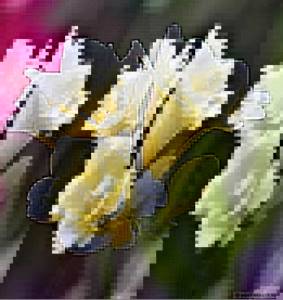
Another name for the species is refracted or broken freesia, since the plant has very thin stems that seem to be broken in several places. It is considered the most miniature, its height rarely exceeds 40 cm. The bush is distinguished by thin spreading branches and spike-shaped inflorescences with 3-5 snow-white or yellow-orange flowers. Blooms in April.
The Alba variety impresses with snow-white petals with purple touches. No less attractive is the “fragrant freesia” variety with yellow petals and an orange spot at the base, which received its name for the most noticeable aroma, similar to the smell of lilies of the valley. 'Odorata' is a beautiful yellow variety with an orange heart and very fragile stems.
Master class of a wedding bouquet of white freesias, roses and eustoma
To create a wedding composition with white color you will need:
- large-headed roses 10-15 pcs.;
- eustoma 2-3 branches;
- freesia 5-8 stems;
- narrow tape for fixation;
- wide white satin ribbon for decoration;
- lace;
- glue gun;
- pins with heads in the form of white beads;
- scissors;
- pruner
Instructions for decorating a wedding bouquet on your own stems using a spiral technique with step-by-step photos:
Let's prepare the stems of the roses, remove all the leaves and thorns from them. We cut the eustoma branches with pruning shears into separate stems with a flower. Let's trim the freesia. We will place all the flowers in different vases with a nutrient solution.
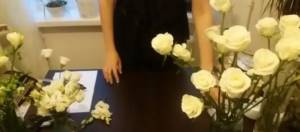
Let's start assembling the bouquet with a rose. We place the two stems crosswise to each other, gradually adding new elements.
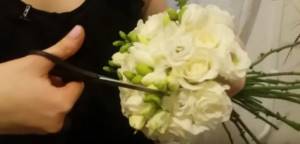
We alternate roses with eustoma and freesia. Along the outer edge of the bouquet we place only the eustoma. We push the sunken rose buds higher to give greater roundness to the top of the bouquet. We trim the edges of unopened freesia buds that stick out too high.
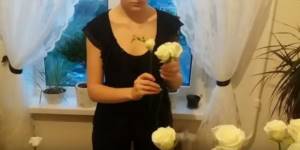
We secure the stems with a narrow tape. We wrap it several times, while pulling it tightly. At the end we form a loop into which we thread the end of the ribbon. Repeat 2-3 times.
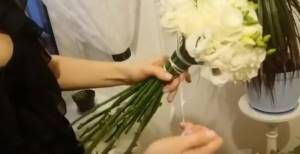
We shorten the stems by 6-7 cm to make it more convenient to decorate and easier to work with. We cut off the remaining thorns with pruning shears.
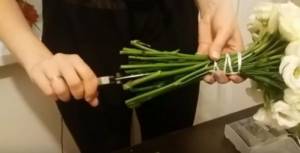
We decorate the flower stems with a wide ribbon.
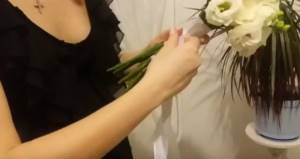
Cut the tape with scissors. Using a glue gun, we secure the edge from sprinkling. Draw a line of glue and bend the tip of the tape.
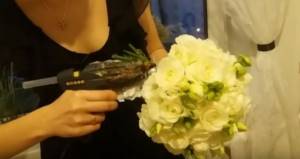
We wrap transparent lace over the satin ribbon. Glue the edge of the lace in the same way as the edge of the ribbon, using a glue gun. But since the glue gets wet in water, we’ll secure it with pins to be safe.
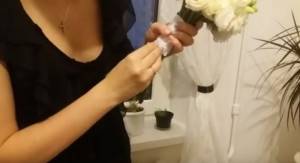
For safety, we plant them deep in the middle of the stems, so that only white beads remain outside.
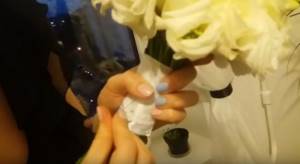
We trim the stems so that the stems protrude no more than 4-6 cm from under the satin cuff.
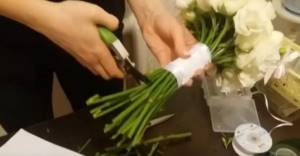
We put the flowers in a vase, pour in enough water so that it does not touch the fabric cuff. We put it in a cool place.
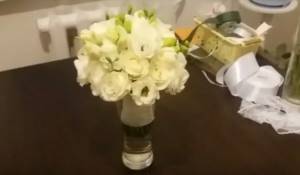
What colors to combine with
Cape lilies of the valley look great in mono compositions. From a large number of inflorescences you can form a bouquet in the shape of a ball or hemisphere. A floral arrangement of this format is suitable for a fitted wedding dress with a full skirt.
It is recommended to complement the bouquets with satin ribbons and decorate them with beads, which will emphasize the delicacy of the petals.
Mono-bouquets of yellow freesias are suitable for fall weddings. Also, monochromatic compositions can be used for themed holidays, choosing shades in accordance with the overall style.
With roses
Lush roses, which symbolize love and beauty, combined with miniature freesia buds, representing purity and trust, will become an excellent basis for a bride’s bouquet. Such compositions look spectacular in wedding photographs.
Roses can have large buds, cup-shaped or elongated, bush, peony-shaped, miniature. Roses of bright colors, when combined with pastel-colored freesias, will attract attention with their touching contrast and add sophistication and femininity to the bride's image.
READ
Bride's bouquet of yellow roses - positive against superstitions
White miniature buds with large peach roses are suitable for a shabby chic wedding. This composition looks airy, tender, touching. Instead of roses or together with them, you can use peonies, dahlias or ranunculus. The composition will be complemented by vintage lace, jewelry, and a brooch.
With eustoma
A bouquet with eustoma looks fantastically beautiful. Eustoma, which is also called the French rose, has large, lush buds, the petals may have fringe along the edges. The inflorescences can be painted in different colors - white, soft pink, shades of red, blue, purple.
Eustoma is considered the personification of sensuality and tenderness. Flowers become the basis of a feminine, fragile composition. The most popular are round-shaped compositions in white and pink colors.
Such an accessory will look best with a fluffy wedding dress of a classic style.
With alstroemeria
A composition of freesias and alstroemeria will help create a gentle romantic image of the bride. Bouquets of these flowers look incredibly sweet and touching.
Alstroemeria symbolizes the beauty of a girl, her uniqueness.
Florists recommend creating compositions based on contrasting combinations. For example, snow-white Cape lilies of the valley can be complemented with alstroemerias in blue or purple shades. This combination would be appropriate for a celebration in Provence style. And long stems will highlight a wedding dress made of light flowing material.
If you need to create a small composition, it should be formed from buds of several shades. These can be yellow and orange freesias combined with white, creamy alstroemerias. This bouquet will look light, cheerful, and is well suited for a wedding held in summer or autumn.
For a celebration in boho, country, or rustic style, bouquets composed of pink and red flowers, complemented by greenery, dried flowers, and ears of flowers are suitable.
Combination with eustoma
The bride's bouquet of freesia and eustoma is an indescribably beautiful sight. Eustoma, or lisianthus, has very beautiful voluminous fluffy buds, sometimes with fringe along the edges. In appearance, this plant is similar to a rose, which is why it is often called the French rose. Lisianthus comes in a variety of colors from white and light pink to dark blue and purple.
Eustoma symbolizes tender feelings and, in alliance with freesia, creates a magnificent sensual combination. Ball-shaped bouquets of these flowers in white or pink-white shades are very popular. A bride's bouquet of freesia and eustoma is well suited for celebrating a classic wedding, paired with the bride's white, lush outfit.
